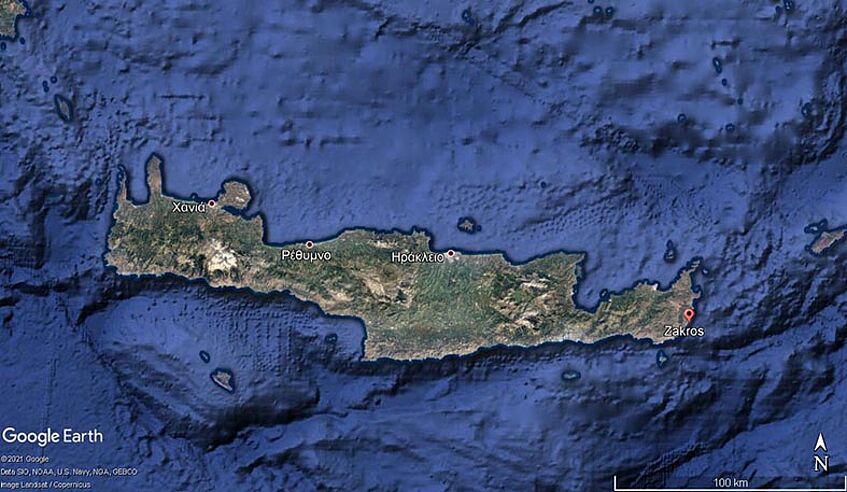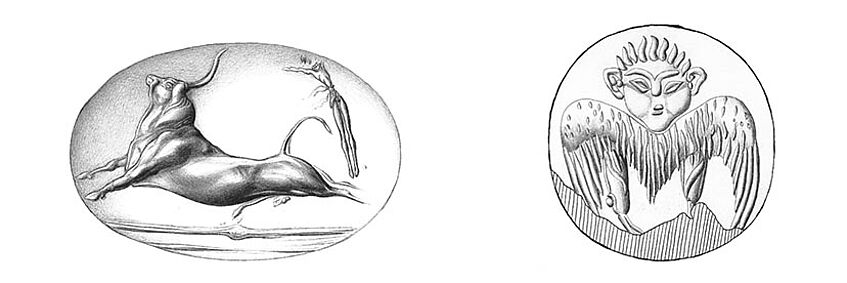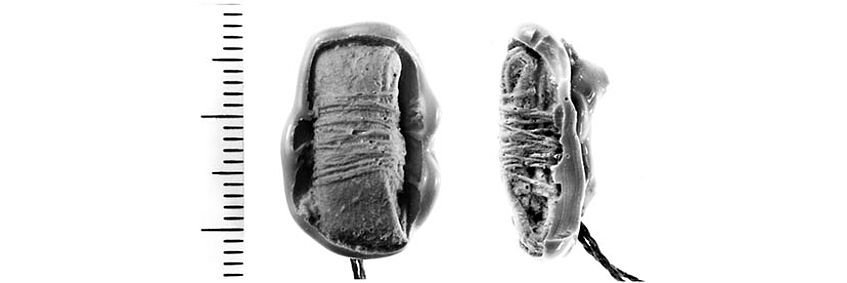Sealing with Images in Kato Zakros: Tracing the Administrative Fingerprint of a Minoan Neopalatial Town
Project:
- FWF - dEr Wissenschaftsfonds, LISE-MEITNER STELLE M 2956-G
Project leader:
- Dr. Maria Anastasiadou
Project partner:
- ao. Univ.-Prof. Mag. Dr. Fritz Blakolmer (University of Vienna)
Cooperation partner:
- Prof. Eleytherios Platon (National and Kapodistrian University of Athens)
The project will offer the final publication of more than 550 clay objects with seal impressions (impressed nodules) from the Minoan palatial town of Kato Zakros is south-east Crete. The majority of the nodules were recovered in House A, a building situated close to the palace and not differing architecturally from private residential structures in the town. A few more were found in the palace together with clay tablets written in the Minoan Linear A script. The nodules date to the Minoan Neopalatial period (ca. 1700-1450 BC).

The island of Crete with Kato Zakros on the south-east coast.
An approximate half of the Kato Zakros seal impressions were made by seals that belong to a type well-known from other Neopalatial sites. The other half were stamped by an enigmatic group of seals engraved with fantastic images created by the combination of different creature and object parts and not otherwise represented in Minoan glyptic.

Drawing of two seal faces impressed on the Kato Zakros nodules: left, one that belongs to a type of seal that is well known from other Neopalatial sites; right, a seal face with a composite device (human head, bird wings, lion legs) that belongs to a seal type solely encountered in Kato Zakros (images: CMS II,7 nos. 39, 117; courtesy of the CMS Heidelberg)
The nodules may carry the impressions of one, two or three different seal faces. This probably suggests that more than one party could ‘sign’ the same nodule and thus, partake in an agreed act. Most nodules were securing small-sized folded documents now only preserved via their impressions in the base of the nodules. These were almost certainly inscribed with Linear A texts that were, as a letter secured in a sealed envelope today, probably only meant to be read by authorised individuals.

Silicon cast of a document imprinted on the base of a Kato Zakros nodule (HMs 1/6, image courtesy of the CMS Heidelberg)
The project aims to shed light into hitherto unexamined aspects of nodule administration in the neopalatial town and examine its relationship to other contemporary sites. It will attempt to the recreate the manner in which the nodules were manufactured, trace the minimum number of individuals involved in their production and reconstruct the processes that led to their accumulation in the town. The seal images will be observed as symbols of the social identity of the actors involved in the administration of the town and indicators of the cultural developments that took place there during the neopalatial period. The Kato Zakros nodule administration will be compared with the administration of other contemporary sites with the aim of better defining the town’s place within the cultural, administrative and, to the extent possible, political milieu of neopalatial Crete.
Thorough primary investigation of the material will first allow its evaluation on the basis of stylistic and iconographic criteria. XRF-analysis (chemical clay analysis) of selected nodules will be then employed with the aim of determining the provenance of key examples. The results above will be approached interpretatively with reference to the research available on the issue of neopalatial inter-site relations and the cultural/political geography of the island.
Basic bibliography on the Kato Zakros impressed nodules:
- Anastasiadou, M. 2020. ‘Intergenderism’ in Neopalatial seal imagery with a special reference to Kato Zakros. Kentro, The Newsletter of the INSTAP Study Center for East Crete 23: 5–10.
- Anastasiadou, M. 2016. Small Puzzles in LM I Zakros. In E. Alram-Stern et al. (eds.), Metaphysis, Ritual, Myth and Symbolism in the Aegean Bronze Age, Proceedings of the 15th International Aegean Conference at the Institute for Oriental and European Archaeology, Department Aegean and Anatolia, Austrian Academy of Sciences and at the Institute of Classical Archaeology, University of Vienna on 22–25 April 2014. Aegeaum 36. Leuven – Liege (Peeters Publishers): 77–85.
- Müller, W. – I. Pini – N. Platon. 1998. Iraklion, Archäologisches Museum. Teil 7. Die Siegelabdrücke von Kato Zakros, unter Einbeziehung von Funden aus anderen Museen. CMS II,7. Berlin (Gebrüder Mann).
- Weingarten, J. 1983. The Zakro Master and his Place in Prehistory. Paul Åströms Förlag (Göteborg).
